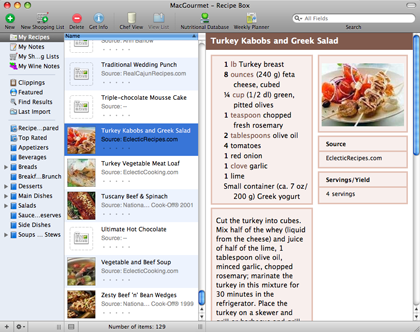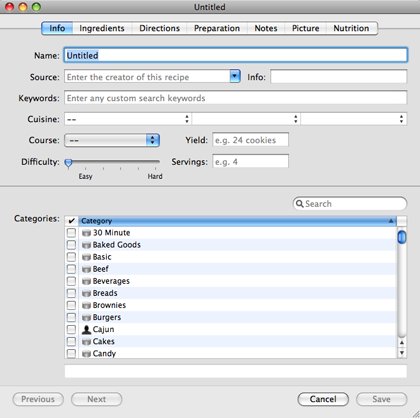Software Review
MacGourmet Deluxe 1.0.3

Developer: Mariner Software
Price: $50 (boxed); $45 (download); family pack also available.
Requirements: Mac OS X 10.4. Universal.
Trial: Fully-featured (15 days).
I learned to cook at an early age and have always done most of the cooking at our house. Over the years, I’ve done a lot of experimenting, inventing a number of recipes, as well as adjusting and tweaking known recipes to better suit my tastes—and the tastes of my family. Needless to say, as the years go by, I’ve wished for a better way to gather and store that information—better than, say, trying to remember what I did the last time, and whether I liked it!
As a Mac guy and a technology enthusiast, I’ve naturally looked for a software solution for this. Until recently, I’ve used Hungry Seacow’s YummySoup! to do it. Lately though, I’ve been using Mariner Software’s MacGourmet Deluxe—and I have to say, it is the total package.
Getting the Basics Right
When it comes to managing the recipes themselves, the task simply isn’t that hard. Building a basic database has been straightforward for quite a while now, and there’s no excuse for not having an easy-to-use interface and system. That said, MacGourmet is as simple to use as any recipe database I’ve seen.
The variables in a program like this aren’t many, but they matter. How is the database laid out? MacGourmet uses a three-pane view similar to Entourage, with categories/groups/collections on the far left, recipe summaries in the middle, and the displayed recipe on the right. It can be changed, however, to a three-pane view more like Apple’s Mail. In addition to the recipe as displayed in the third pane, you may also choose Item View to see it in its own window, or Chef View to have it enlarged to fill the screen for easy viewing while cooking.

The other primary variables—which I deal with as a user, at least—are the number of fields and what they are. MacGourmet excels here, with a field for almost every piece of information I could think of, pre-populated with dozens (or possibly hundreds) of the most common options in many cases. Adding new options is no problem, nor is having no data for a field—not unlike Apple’s Address Book, empty fields are simply not displayed.
The last problem I’ve I encountered with any frequency in a database like this is what happens when the types and amount of information it is capable of handling increase significantly. Often, this makes for an overwhelming amount of information displayed, a busy and sticky-mushy interface, or both. In MacGourmet, the basic recipe management is only the tip of the iceberg—the frosting on the cake, if you will—yet the rest of it is handled with elegance and simplicity.
Expanding Options
Getting information into a database like this is as vital as the actual management. MacGourmet makes it very easy to add a recipe entirely by hand—a dialog with tabs for various types of information is plain and simple. But what about recipes that are already digital—say, from a Web site or a PDF, an e-mail, or some other document? For this, MacGourmet makes good use of Apple’s Services menu—a universal command menu that allows any application to embed commands and connections to any other application. The Services provided with MacGourmet—combined with an equally easy Clippings manager in the program itself—renders adding recipes into the mix a snap.
I know. This is starting to sound like a Ginsu knife commercial.

But wait, there’s more! MacGourmet includes a weekly meal planner that is drag-and-drop simple, and that meal planner (or any individual recipe) can generate a shopping list. You can also send your meal plan to iCal, complete with times (which you set) for the meals themselves. As you are planning your meals, feel free to make use of the Nutrition Database (populated with data from the USDA) that is included and automatically tagged to your recipes as you enter them.
Alongside the digital recipe box and meal- and shopping-planning tools is a full-fledged wine database. Track the wines you’ve tried before with all of the data that a collector or taster might have. You can even keep up with the inventory in your personal wine cellar. I’m not really a wine guy, but I’ve worked in enough restaurants to realize how important this information can be.
Sharing and exporting recipes is a piece of cake, with many options. You can print to standard sheets of paper, of course, and index cards. But MacGourmet also has a fully functioning Cookbook Builder built-in, which lends an entirely different component to sharing recipes. Select your recipes, decide whether to include images, add text pages that you edit, even divide up into chapters, and choose your cover—then print on your home printer, send it to PDF to share in that way, or format it for a print-on-demand service.
MacGourmet is set up to allow you to share your recipes, recipe notes, and wine notes on the Web, either through MobileMe or via a WebDAV server. Or you can publish recipes and notes to a blog easily. You may also export to iPod notes, simple text files, and in rich text format.
It’s in the Details
There are lots of small features that make MacGourmet a true treat. Cupboard Find is a good example. Put in the items you already have in your fridge, cupboard, and pantry, and MacGourmet will suggest any recipes that fit.
Linking recipes is another cool feature. Do you have a separate recipe for the special frosting that goes on Aunt Betty’s pound cake? Link them—a new Related Items field appears in the recipe box for both. You may link as many recipes as you like, so complexity and simplicity may co-exist.
The developer’s attention to detail can be found in other advanced Find features, smart lists, and groups, and a lot of great printing options. It has included several different printing layouts, all quite attractive, that allow you to further personalize your recipes to your tastes as you print them.
Very Few Complaints
As much as I like MacGourmet Deluxe, there are a couple of things I would like to see improved. They aren’t very many, though—it seemed as if every time I thought of something I would like it to do, I found that it already did it without much trouble!
It’s possible to set preparation times (with great specificity) within the recipes themselves. Wouldn’t it be great if MacGourmet would calculate total prep time for all the elements in a meal and export that to iCal with the meal plan as well? I know, this is a niggly detail, but I’m frankly surprised it isn’t already built-in, given the attention to such details that Mariner already has.
Similarly, it seems to me that a very useful feature might be to allow wine notes to be connected to certain meals by linked relationships. It’s possible to connect, say, a certain roast with a specially prepared rice, so why not also include wines that you’ve found to especially complement?
Summary
It all boils down to this: if you need a database to manage your recipes, there are several available, though none has been more pleasant for me to use than MacGourmet Deluxe. If you need or want options for dealing with your recipes beyond basic collection and management—meal plans, nutritional information, shopping lists, wine notes, even cookbook creation—then MacGourmet Deluxe is a great option, with very few shortcomings or flaws.
If the extra features are simply more than you need, and you’d prefer to do without the Nutrition database, the Mealplan maker, and the Cookbook Builder—or you’d rather add one or two, but not the third—then you might prefer to look at Advenio’s MacGourmet, which is the same application without these tools, and in a download-only version, for $25. Each of them is available as a plug-in for $12, so the economics of more than one plug-in quickly point to the Mariner version. Advenio and Mariner have a republishing agreement that sets up this peculiar but flexible set of options.
Reader Comments (3)
Add A Comment